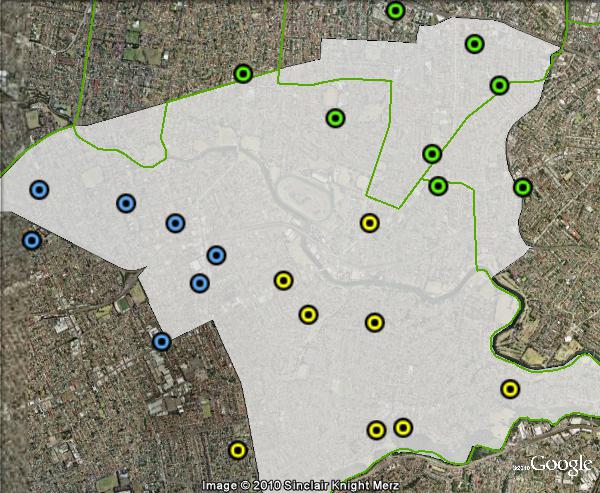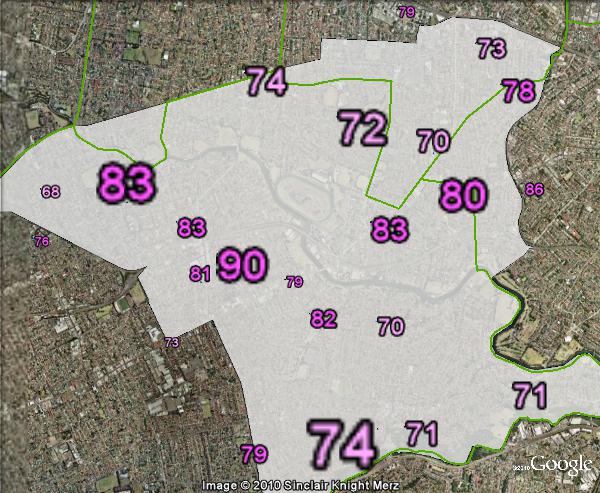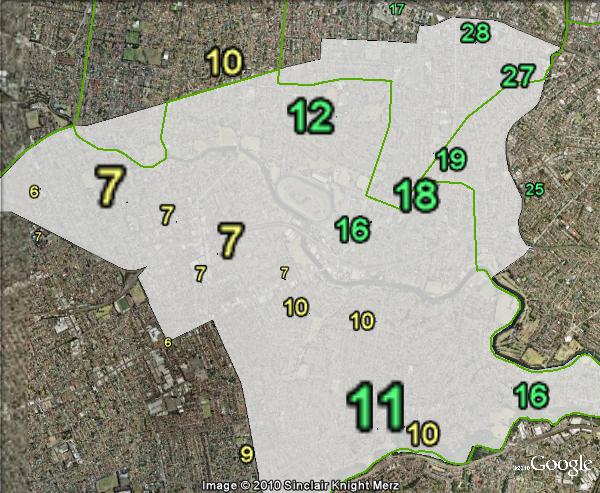ALP 27.1%
Incumbent MP
Linda Burney, since 2003.
Geography
Inner south-west of Sydney. Canterbury covers eastern parts of the City of Canterbury and small parts of the neighbouring Marrickville, Ashfield and Burwood local government areas. It covers the suburbs of Ashbury, Summer Hill, Hurlstone Park, Canterbury, Campsie and Earlwood.
History
The district of Canterbury has sent members to the Legislative Assembly since 1859, with the exception of three elections in the 1920s. The seat has been held by the ALP continuously since 1935.
The district of Canterbury was included in the multi-member district of St George from 1920 to 1927. When the seat was restored in 1927, it was won by the ALP’s Arthur Tonge. He had been elected to a casual vacancy in the district of North Shore in 1926.
Tonge was defeated by 111 votes in 1932 by the United Australia Party’s Edward Hocking. He regained the seat in 1935, and held it until 1962, when he lost Labor endorsement and retired.
Kevin Stewart defeated Tonge for preselection in Canterbury in 1962. He served as a minister in the Labor government from 1976 to 1985, when he resigned from Parliament to take up appointment as NSW Agent-General in London.
The 1986 by-election was won by Canterbury mayor Kevin Moss. He retained the seat throughout the 1980s and 1990s, retiring at the 2003 election.
Canterbury was won in 2003 by Linda Burney, the first indigenous member of the NSW Parliament. She has served as a minister in the Labor government since the 2007 election.
Candidates
- Linda Burney (Labor)
- Marc Rerceretnam (Greens)
- Ken Nam (Liberal)
- Albert Fam (Christian Democratic Party)
Political situation
Canterbury is a safe Labor seat.
2007 result
| Candidate | Party | Votes | % | Swing |
| Linda Burney | ALP | 24,634 | 57.1 | +1.6 |
| Philip Mansour | LIB | 7,907 | 18.3 | +2.1 |
| Christine Donayre | GRN | 5,629 | 13.0 | +1.6 |
| Jing Ren | UNI | 2,809 | 6.5 | +0.6 |
| Ehab Hennien | CDP | 1,359 | 3.1 | +3.0 |
| Alan Cronin | AAFI | 822 | 1.9 | +1.9 |
2007 two-candidate-preferred result
| Candidate | Party | Votes | % | Swing |
| Linda Burney | ALP | 29,046 | 77.1 | -0.3 |
| Philip Mansour | LIB | 8,609 | 22.9 | +0.3 |
Booth breakdown
Booths in Canterbury have been divided into three areas: Earlwood in the south, Campsie in the west, and an area covering the north of the seat. The ALP polled just over 75% in the north and Earlwood and over 82 in Campsie.
The Greens vote varies from over 18% in the north to 6.7% in Campsie.

| Voter group | GRN % | ALP 2CP % | Total votes | % of votes |
| Earlwood | 11.5 | 75.6 | 13,331 | 30.9 |
| North | 18.2 | 75.8 | 12,968 | 30.0 |
| Campsie | 6.7 | 82.3 | 9,486 | 22.0 |
| Other votes | 15.1 | 72.8 | 7,375 | 17.1 |




Earlwood used to be a reasonably strong Liberal area, does anyone know what’s happened over the past quarter of a century?
90% 2pp? Is that a typo, or Labor’s best booth in NSW?
There’s a 93% ALP booth in Wollongong, and I’m not sure if that’s the highest ALP booth in NSW.
90% for 1 booth? Jesus. Where’s that?
Matt, Antony Green mentions the type of area Earlwood used to be in his book “The Electoral History of NSW”. You can buy it at the Lands office in town near the Mint on Macquarie Street.
As I understand it, pre-Wranslide in the 70s, Earlwood was part of the “wowser belt” of suburbs (Concorde, Strathfield, Burwood, down thru to Earlwood and Georges River) that solidly voted against liberalising closing hours in referenda during the 50s and 60s, and was full of respectable lower and middle middle class WASPs, who once non-anglo migrants started arriving, started to migrate to the north shore, Hills, etc. Think John Howard’s parents. There’s a reason the NSW Orange Order has its office on Parramatta Road – their members lived in suburbs nearby presumably.
Once they left, they were replaced steadily by non-anglo voters more likely to vote Labor. Presumably because they were in more manual roles than professionals?? Housing stock became cheaper? Not sure.
Plus when a seat changes and the former incumbent goes, the losing party loses resources and are unable to fight as strong a campaign in the future. Voters change their voting preferences.
If you look at federal results over the last decade or so, the Earlwood/Bardwell Park area has been softer for Labor than surrounding parts of Barton and Watson. So I guess there’s still a core Liberal vote there somewhere.
Interesting that Earlwood was once safe Liberal – the area doesn’t seem that upper class. Really the only real upper-class area in Southern Sydney are in the Eastern Suburbs, Strathfield, or Canada Bay.
Some areas along the Georges River like Picnic Point, Lugarno, Oatley, Blakehust, Connells Point are pretty affluent as well.
MDMConnell – yes you are right and hence the reason I believe Oatley and East Hills will go to the Liberals. But all of those areas are bit further out than Earlwood. The answer to the Earlwood question is simply the change in demographics to a Muslim Lebanese community who have tended to support the ALP.
MDM, yeah I lived near there, I know Georges River is pretty affluent. As is the Shire.
FAILURES in Earlwood that MP Linda Burney was involved in even though she was omitted from barely a mention in the NSW Ombudsman report http://bit.ly/cHxhdO
Questions need to be asked whether MP Linda Burney refused to address the issues because the Mayor of Canterbury Council is Lakemba Labor MP Robert Furolo. Failures that then led to an 80 year old woman being dragged through the supreme court and left with a legal debt of over $200,000.
Other websites that delve into the numerous failures of the Council, Mr Furolo, Ms Burney, the numerous Local Govt Ministers who ignored this dishonest Council can be seen at:
http://indymedia.org.au/2010/02/20/nsw-ombudsman-confirms-maladministration-at-canterbury-city-council
http://councilgripe.com/content/unreasonable-conduct-canterbury-city-council
http://councilgripe.com/content/environmental-vandalism-canterbury-city-council
http://picasaweb.google.com/supportmallone
It also needs to be mentioned Earlwood, still remains a more affluent suburb than its western neighbours such as Campsie and Canterbury, with have a significantly different ethnic mix, who are usually more likely to vote Labor.
My prediction: Labor retain, 10-15% swing to Liberals.
I also expect a big swing against Linda Burney – not just for the incompetence surrounding the Mallone undercliffe situation, but her dreadful record in DOCS. She should go, maybe its time with all the anti Labor views. I am voting for Ken!
John, just a quick question for why not a vote for Marc? I could see he’s better known in the north-east part of the seat. He looks like a relatively strong candidate with similar credentials to Ken, except not a real estate agent.
I just really don’t like real estate agents.
Well, it appears Earlwood will vote Labor until the cows come home now – all booths in Earlwood recorded Labor majorities between 53-57%.
The Liberal’s loss of Earlwood in the 1977 by-election may have had something to do with their choice of candidate. Allan Jones, now a radio shock jock. He stood in former Liberal premier Eric Willis’s old seat and lost it to Ken Gabb (Labor) who beat him again in the State General
Election later that year and held it until 1988 when the Liberals won it back.
In the process Jones gave Neville Wran a majority in the House, where they previously had to depend on John Hatton (Independent). Don’t say Jones never did Labor a favor.
Sorry, 1978 by election and general election.